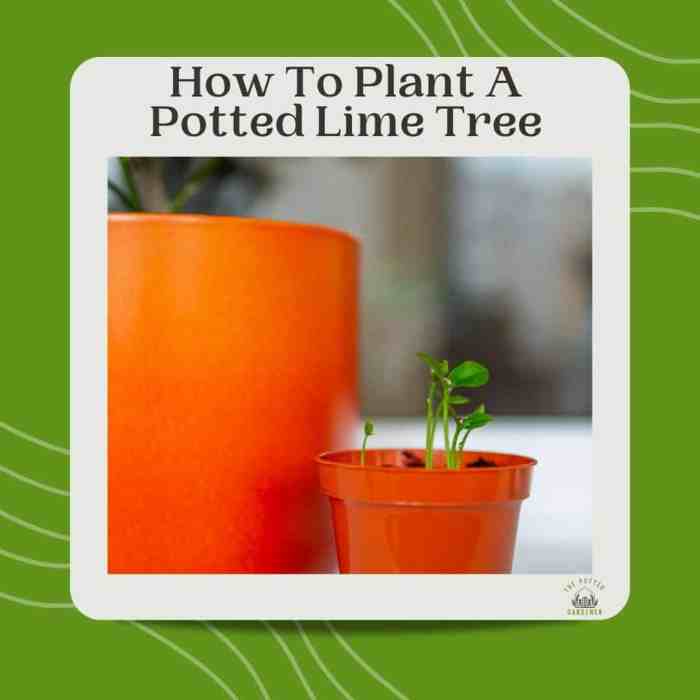Ideal Climate Conditions for Lime Tree Planting

When to plant lime tree – Yo, Surabaya peeps! Planting a lime tree? Think it’s just chucking a seed in the ground andbam*, fresh lime juice? Nah, fam. Getting a thriving lime tree needs the right vibes – we’re talking climate, soil, the whole shebang. Let’s break it down, urban gardening style.
Temperature Tolerance
Lime trees, like most tropical fruits, are total sun worshippers and prefer consistently warm temperatures. The ideal temperature range for most lime varieties sits between 20-30°C (68-86°F). Anything below 10°C (50°F) can seriously stunt their growth, and prolonged exposure to freezing temperatures (below 0°C or 32°F) can be lethal, causing irreversible damage to the tree. Think of it like this: your lime tree is like that friend who always needs a beach vacation – warm and sunny is key.
If you live in a place with cooler winters, you might need to consider some protection, like a greenhouse or even just a good blanket on really chilly nights.
Sunlight Requirements
Sunshine is basically lime tree fuel. These guys need at least six to eight hours of direct sunlight daily to photosynthesize properly and produce those juicy limes. Less sunlight means fewer limes and potentially weaker growth. Think of it as their daily dose of vitamin D – essential for a healthy and productive life. Planting them in a shady spot?
Forget about it – you’ll end up with a sad, unproductive tree. Find that sunny spot, fam!
Soil pH
Soil pH is crucial. Lime trees thrive in slightly acidic to neutral soil, with an ideal pH range of 6.0 to 6.8. If your soil is too alkaline (high pH), the tree might struggle to absorb essential nutrients like iron and zinc, leading to chlorosis (yellowing of leaves). Conversely, soil that’s too acidic (low pH) can also cause problems.
Testing your soil’s pH before planting is a must – you can easily get a soil testing kit from most gardening stores. Adjusting the pH might involve adding amendments like sulfur (to lower pH) or lime (to raise pH), depending on your soil’s needs. It’s all about finding that sweet spot for optimal nutrient absorption.
Soil Drainage
Soggy roots are a lime tree’s worst nightmare. Excellent drainage is non-negotiable. Lime trees hate having their roots sitting in water, which can quickly lead to root rot and ultimately kill the tree. Well-drained soil allows for proper aeration and prevents waterlogging. If your soil tends to be heavy clay, consider amending it with organic matter like compost to improve drainage.
Think of it like this: your lime tree needs to breathe, just like you do.
Lime Tree Variety Climate Preferences
| Variety | Temperature Tolerance (°C) | Sunlight Needs (hours/day) | Soil Drainage Preference |
|---|---|---|---|
| Key Lime | 20-32 | 6-8 | Excellent |
| Persian Lime | 15-35 | 6-8 | Well-drained |
| Rangpur Lime | 10-35 | 6-8 | Well-drained |
| Tahiti Lime | 15-35 | 6-8 | Well-drained |
Post-Planting Care and Maintenance
Yo, Surabaya peeps! So you’ve planted your lime tree – congrats! Now, the real work begins. Keeping your lime tree thriving takes some effort, but trust me, the fresh, juicy limes are totally worth it. Think of it like leveling up your gardening skills – it’s all about consistent care and attention.
Watering Schedule for Newly Planted Lime Trees
Watering a newly planted lime tree is crucial for its survival and establishment. Consistent moisture encourages strong root development, which is key for a healthy, productive tree. During the first few weeks after planting, water deeply and regularly, aiming for about 1-2 inches of water per week. This translates to about 10-20 liters of water depending on the size of your tree and the weather conditions.
Check the soil moisture regularly; if the top inch or two feels dry, it’s time to water again. Reduce watering frequency as the tree establishes itself and its roots reach deeper into the soil. Remember, it’s better to water deeply less often than to shallowly water frequently. Overwatering can lead to root rot, so be mindful of your watering habits.
Think of it like giving your tree a good, long drink instead of lots of little sips.
Mulching Benefits and Application for Lime Trees
Mulching is like giving your lime tree a VIP treatment. It’s a game-changer, seriously. Spread a 2-3 inch layer of organic mulch, like wood chips or shredded bark, around the base of your tree, keeping it a few inches away from the trunk. This helps retain soil moisture, reducing the frequency of watering. It also suppresses weeds, which compete with your lime tree for nutrients and water.
Plus, mulch helps regulate soil temperature, protecting the roots from extreme heat and cold. Over time, the mulch decomposes and adds valuable nutrients to the soil, boosting your lime tree’s growth. Imagine it as a cozy blanket for your tree’s roots, keeping them warm and happy.
Fertilizing Lime Trees
Feeding your lime tree is essential for healthy growth and abundant fruit production. Use a balanced citrus fertilizer, following the instructions on the package carefully. Generally, you’ll fertilize your lime tree several times a year, usually in spring and summer. Avoid over-fertilizing, as this can harm the tree. Remember, a little goes a long way! A good rule of thumb is to apply fertilizer in a ring around the tree, a few inches from the trunk, then water it in well.
Think of it like giving your tree a delicious, nutritious meal to help it grow big and strong. Using a slow-release fertilizer can help minimize the frequency of application.
Protecting Young Lime Trees from Pests and Diseases
Protecting your young lime tree from pests and diseases is vital for its survival and long-term health. Regularly inspect your tree for signs of pests or diseases. Common pests include aphids, scale, and citrus mites. Diseases can include citrus canker and gummosis. Early detection and treatment are crucial.
Use organic pest control methods whenever possible, such as neem oil or insecticidal soap. For diseases, proper sanitation and pruning can help prevent spread. If you notice significant issues, consult a local gardening expert or agricultural extension office for advice. Think of it like being a tree doctor – keeping a close eye on your tree’s health is crucial for its well-being.
The best time to plant a lime tree is during spring or early summer after the last frost. Unlike the demanding care of a fiddle leaf fig tree indoor plant , lime trees thrive in warm, sunny locations. However, both require well-draining soil for optimal growth, highlighting the importance of proper soil preparation regardless of the chosen citrus or houseplant.
Lime Tree Growth Stages, When to plant lime tree
Picture this: You plant a tiny lime sapling, barely bigger than your hand. Its delicate stem reaches skyward, a few small leaves unfurling. Over the next few years, it slowly grows taller and wider, developing a strong root system. The trunk thickens, and more branches appear, creating a more substantial structure. After a few years, small buds appear, followed by the beautiful, fragrant lime blossoms.
These blossoms eventually give way to tiny, green limes, which slowly swell and ripen to their vibrant, yellow-green color, ready for you to harvest and enjoy. Eventually, your once-tiny sapling becomes a mature lime tree, providing you with years of delicious, homegrown limes – a true testament to your green thumb!
Factors Affecting Planting Success: When To Plant Lime Tree

Yo, Surabaya peeps! Planting a lime tree ain’t just about chucking a seedling in the ground and hoping for the best. There’s a whole bunch of stuff that can make or break your citrus dreams. Let’s break down the real deal on what can impact your lime tree’s success.
Frost Damage and Protection
Frost is a major enemy for young lime trees. Those tender shoots and leaves are super vulnerable to freezing temperatures. Severe frost can cause leaf damage, stunted growth, and even kill the tree. To protect your young lime, consider using frost cloths or blankets to cover the tree on nights when frost is predicted. You could also build a small enclosure around the tree using clear plastic sheeting to create a mini-greenhouse effect.
Think of it like giving your lime a cozy winter jacket! Another strategy is to plant your lime in a sheltered location, like near a south-facing wall, where it’ll receive more sunlight and be protected from cold winds. Remember, prevention is key!
Pests and Diseases
Lime trees, like any other plant, are susceptible to various pests and diseases. Common culprits include citrus aphids, scale insects, and citrus canker. Aphids suck the sap from leaves, causing stunted growth and yellowing. Scale insects create a protective shell, making them difficult to control. Citrus canker is a bacterial disease that causes lesions on leaves and fruits.
Regular inspection of your tree is crucial. Early detection is your best weapon. For treatment, you can use insecticidal soap for aphids and scale, and for citrus canker, pruning affected branches and applying copper-based fungicides might be necessary. Always follow the instructions on any pesticide carefully, yo.
Pruning for Healthy Growth and Fruit Production
Proper pruning is essential for maintaining a healthy and productive lime tree. Regular pruning removes dead, damaged, or diseased branches, allowing for better air circulation and sunlight penetration. It also helps to shape the tree and encourage fruit production. Pruning should ideally be done during the dormant season (winter) to minimize stress on the tree. Overgrown branches should be thinned out to promote good airflow, preventing diseases.
Remember, a well-pruned lime tree is a happy lime tree!
Container Planting vs. Bare-Root Planting
Choosing between container planting and bare-root planting depends on your preferences and the availability of saplings. Container-grown lime trees are easier to handle and transplant, with established root systems that reduce transplant shock. They are also generally more expensive. Bare-root trees are less expensive but require more care during planting to ensure the roots are properly established. The key here is to choose healthy saplings regardless of the planting method and ensure proper planting techniques.
Troubleshooting Common Problems
Let’s face it, things don’t always go as planned. Here’s a quick guide for some common issues:
| Problem | Possible Cause | Solution |
|---|---|---|
| Yellowing leaves | Nutrient deficiency, overwatering, or root rot | Test soil pH, adjust watering, and improve drainage. Consider applying fertilizer. |
| Stunted growth | Lack of sunlight, pests, or disease | Ensure adequate sunlight, inspect for pests and diseases, and treat accordingly. |
| No fruit production | Lack of pollination, nutrient deficiency, or improper pruning | Consider hand-pollination, fertilize appropriately, and prune properly. |
FAQ Summary
What type of lime tree is best for my area?
The best lime tree variety depends on your specific climate and hardiness zone. Consult your local nursery or agricultural extension office for recommendations.
How often should I water a newly planted lime tree?
Water deeply and regularly, especially during dry periods. The frequency will depend on your climate and soil conditions, but aim for consistently moist soil, not waterlogged.
What should I do if my lime tree shows signs of disease?
Identify the disease (if possible) and consult your local nursery or agricultural extension office for treatment options. Proper sanitation and preventative measures are crucial.
Can I grow a lime tree in a container?
Yes, container planting is possible, but choose a large enough pot to accommodate the tree’s root system and ensure adequate drainage. Regular fertilization and watering will be necessary.
